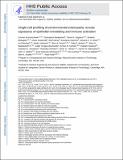Single-cell profiling of environmental enteropathy reveals signatures of epithelial remodeling and immune activation
Author(s)
Kummerlowe, Conner; Mwakamui, Simutanyi; Hughes, Travis K; Mulugeta, Nolawit; Mudenda, Victor; Besa, Ellen; Zyambo, Kanekwa; Shay, Jessica ES; Fleming, Ira; Vukovic, Marko; Doran, Ben A; Aicher, Toby P; Wadsworth, Marc H; Bramante, Juliet Tongue; Uchida, Amiko M; Fardoos, Rabiah; Asowata, Osaretin E; Herbert, Nicholas; Yilmaz, Ömer H; Kløverpris, Henrik N; Garber, John J; Ordovas-Montañes, José; Gartner, Zev J; Wallach, Thomas; Shalek, Alex K; Kelly, Paul; ... Show more Show less
DownloadAccepted version (2.693Mb)
Open Access Policy
Open Access Policy
Creative Commons Attribution-Noncommercial-Share Alike
Terms of use
Metadata
Show full item recordAbstract
<jats:p>Environmental enteropathy (EE) is a subclinical condition of the small intestine that is highly prevalent in low- and middle-income countries. It is thought to be a key contributing factor to childhood malnutrition, growth stunting, and diminished oral vaccine responses. Although EE has been shown to be the by-product of a recurrent enteric infection, its full pathophysiology remains unclear. Here, we mapped the cellular and molecular correlates of EE by performing high-throughput, single-cell RNA-sequencing on 33 small intestinal biopsies from 11 adults with EE in Lusaka, Zambia (eight HIV-negative and three HIV-positive), six adults without EE in Boston, United States, and two adults in Durban, South Africa, which we complemented with published data from three additional individuals from the same clinical site. We analyzed previously defined bulk-transcriptomic signatures of reduced villus height and decreased microbial translocation in EE and showed that these signatures may be driven by an increased abundance of surface mucosal cells—a gastric-like subset previously implicated in epithelial repair in the gastrointestinal tract. In addition, we determined cell subsets whose fractional abundances associate with EE severity, small intestinal region, and HIV infection. Furthermore, by comparing duodenal EE samples with those from three control cohorts, we identified dysregulated WNT and MAPK signaling in the EE epithelium and increased proinflammatory cytokine gene expression in a T cell subset highly expressing a transcriptional signature of tissue-resident memory cells in the EE cohort. Together, our work elucidates epithelial and immune correlates of EE and nominates cellular and molecular targets for intervention.</jats:p>
Date issued
2022Department
Massachusetts Institute of Technology. Computational and Systems Biology Program; Massachusetts Institute of Technology. Institute for Medical Engineering & Science; Massachusetts Institute of Technology. Department of Chemistry; Koch Institute for Integrative Cancer Research at MIT; Ragon Institute of MGH, MIT and HarvardJournal
Science Translational Medicine
Publisher
American Association for the Advancement of Science (AAAS)
Citation
Kummerlowe, Conner, Mwakamui, Simutanyi, Hughes, Travis K, Mulugeta, Nolawit, Mudenda, Victor et al. 2022. "Single-cell profiling of environmental enteropathy reveals signatures of epithelial remodeling and immune activation." Science Translational Medicine, 14 (660).
Version: Author's final manuscript